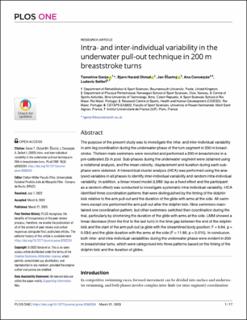| dc.contributor.author | Gonjo, Tomohiro | |
| dc.contributor.author | Olstad, Bjørn Harald | |
| dc.contributor.author | Štastný, Jan | |
| dc.contributor.author | Conceição, Ana | |
| dc.contributor.author | Seifert, Ludovic | |
| dc.date.accessioned | 2023-10-23T12:03:29Z | |
| dc.date.available | 2023-10-23T12:03:29Z | |
| dc.date.created | 2023-04-27T14:28:42Z | |
| dc.date.issued | 2023 | |
| dc.identifier.citation | PLoS ONE. 2023, 18(3), Artikkel e0283234. | en_US |
| dc.identifier.issn | 1932-6203 | |
| dc.identifier.uri | https://hdl.handle.net/11250/3098090 | |
| dc.description | This is an open access article distributed under the terms of the Creative Commons Attribution License, which permits unrestricted use, distribution, and reproduction in any medium, provided the original author and source are credited. | en_US |
| dc.description.abstract | The purpose of the present study was to investigate the intra- and inter-individual variability in arm-leg coordination during the underwater phase of the turn segment in 200 m breaststroke. Thirteen male swimmers were recruited and performed a 200 m breaststroke in a pre-calibrated 25 m pool. Sub-phases during the underwater segment were obtained using a notational analysis, and the mean velocity, displacement and duration during each sub-phase were obtained. A hierarchical cluster analysis (HCA) was performed using the analysed variables in all phases to identify inter-individual variability and random intra-individual variability. In addition, a linear mixed model (LMM: lap as a fixed effect and the participant as a random effect) was conducted to investigate systematic intra-individual variability. HCA identified three coordination patterns that were distinguished by the timing of the dolphin kick relative to the arm pull-out and the duration of the glide with arms at the side. All swimmers except one performed the arm pull-out after the dolphin kick. Nine swimmers maintained one coordination pattern, but other swimmers switched their coordination during the trial, particularly by shortening the duration of the glide with arms at the side. LMM showed a linear decrease (from the first to the last turn) in the time gap between the end of the dolphin kick and the start of the arm pull-out (a glide with the streamlined body position; F = 9.64, p = 0.034) and the glide duration with the arms at the side (F = 11.66, p = 0.015). In conclusion, both inter- and intra-individual variabilities during the underwater phase were evident in 200 m breaststroke turns, which were categorised into three patterns based on the timing of the dolphin kick and the duration of glides. | en_US |
| dc.language.iso | eng | en_US |
| dc.subject | arms | en_US |
| dc.subject | body limbs | en_US |
| dc.subject | dolphins | en_US |
| dc.subject | hierarchical clustering | en_US |
| dc.subject | motion | en_US |
| dc.subject | musculoskeletal mechanics | en_US |
| dc.subject | swimming | en_US |
| dc.subject | velocity | en_US |
| dc.title | Intra- and inter-individual variability in the underwater pull-out technique in 200 m breaststroke turns | en_US |
| dc.type | Peer reviewed | en_US |
| dc.type | Journal article | en_US |
| dc.description.version | publishedVersion | en_US |
| dc.rights.holder | © 2023 Gonjo et al. | en_US |
| dc.source.pagenumber | 17 | en_US |
| dc.source.volume | 18 | en_US |
| dc.source.journal | PLoS ONE | en_US |
| dc.source.issue | 3 | en_US |
| dc.identifier.doi | 10.1371/journal.pone.0283234 | |
| dc.identifier.cristin | 2143866 | |
| dc.description.localcode | Institutt for fysisk prestasjonsevne / Department of Physical Performance | en_US |
| dc.source.articlenumber | e0283234 | en_US |
| cristin.ispublished | true | |
| cristin.fulltext | original | |
| cristin.qualitycode | 1 | |
